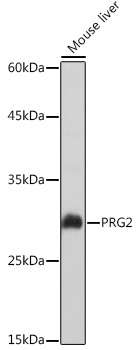PRG2 antibody [HL2547]
GTX638919
ApplicationsImmunoFluorescence, Western Blot, ImmunoCytoChemistry, ImmunoHistoChemistry, ImmunoHistoChemistry Paraffin
Product group Antibodies
TargetPRG2
Overview
- SupplierGeneTex
- Product NamePRG2 antibody [HL2547]
- Delivery Days Customer9
- Application Supplier NoteWB: 1:1000-1:10000. *Optimal dilutions/concentrations should be determined by the researcher.Not tested in other applications.
- ApplicationsImmunoFluorescence, Western Blot, ImmunoCytoChemistry, ImmunoHistoChemistry, ImmunoHistoChemistry Paraffin
- CertificationResearch Use Only
- ClonalityMonoclonal
- Clone IDHL2547
- Concentration1 mg/ml
- ConjugateUnconjugated
- Gene ID5553
- Target namePRG2
- Target descriptionproteoglycan 2, pro eosinophil major basic protein
- Target synonymsBMPG, MBP, MBP1, proMBP, bone marrow proteoglycan, eosinophil granule major basic protein, eosinophil major basic protein, natural killer cell activator, proteoglycan 2 preproprotein, proteoglycan 2, bone marrow (natural killer cell activator, eosinophil granule major basic protein)
- HostRabbit
- IsotypeIgG
- Protein IDP13727
- Protein NameBone marrow proteoglycan
- Scientific DescriptionThe protein encoded by this gene is the predominant constituent of the crystalline core of the eosinophil granule. High levels of the proform of this protein are also present in placenta and pregnancy serum, where it exists as a complex with several other proteins including pregnancy-associated plasma protein A (PAPPA), angiotensinogen (AGT), and C3dg. This protein may be involved in antiparasitic defense mechanisms as a cytotoxin and helminthotoxin, and in immune hypersensitivity reactions. The encoded protein contains a peptide that displays potent antimicrobial activity against Gram-positive bacteria, Gram-negative bacteria, and fungi. It is directly implicated in epithelial cell damage, exfoliation, and bronchospasm in allergic diseases. Alternatively spliced transcript variants encoding different isoforms have been found for this gene. [provided by RefSeq, Nov 2014]
- Storage Instruction-20°C or -80°C,2°C to 8°C
- UNSPSC12352203



